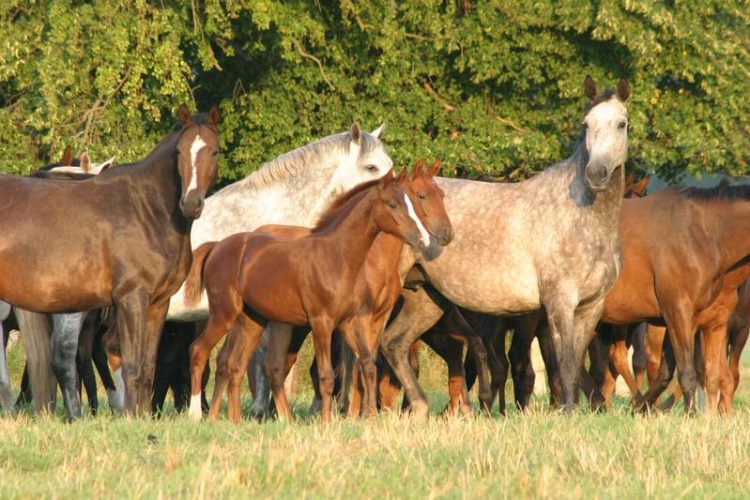Maternal influences – The contribution of mare genetics to gestation length and foal sex

Mare pedigree influences offspring more than previously thought. Photo: Dr. Juliane Kuhl/Vetmeduni Vienna
Owners of sport and leisure horses are keen on knowing the parentage of their animals. A horse with a good pedigree will often have the desired characteristics in terms of speed, physique and health.
At the Graf Lehndorff Institute for Equine Science, a joint research institution of the Vetmeduni Vienna and the Brandenburg State Stud in Germany, Juliane Kuhl and Christine Aurich investigated the degree to which the maternal lineage influences gestation length and foal characteristics. Together with statistician Kathrin Stock of the agricultural statistics centre VIT in Germany, they analysed the data records for 640 pregnancies in 142 mares.
Maternal lineage influences gestation length
The broodmares could be assigned to different mare families or lineages. The analysis revealed that the average length of gestation, which in horses ranges between 320 and 360 days, varies from family to family. The gestation length of some maternal lineages was on average 10 days longer than in other families. The fact that gestation length for male foals tends to be generally longer than for female foals is added to the variation from family to family.
“We can still not predict the exact time of birth. The individual fluctuations among individual pregnancies are simply too large. But the information gained from the study can help us to narrow the possible range,” says first author Juliane Kuhl.
“The length of gestation is also of interest for horse breeders. Ideally, a broodmare should give birth to a foal every year. Due to the average gestation which covers approximately 11 months, longer gestation lengths result in a delay in birth of the next foal. Breeders are interested in having foals born at the beginning of the year, as the horses will then compete better against animals born in the same year,” Kuhl explains.
Mare pedigree influences foal sex ratio
The study also showed that certain maternal lineages produce more female than male foals. The age of the mare also plays a role. Young mares who have their first pregnancy when they are three years old will produce more female foals. Older mares also tend to have more female offspring. For middle-aged mares between four and twelve years the foal sex ratio is balanced.
“These results are important for horse breeders. They could possibly choose their mares depending on the desired sex of a foal,” Kuhl believes.
The mechanism behind this phenomenon remains unclear, however.
“We suspect that these effects are due to the differences in mitochondrial DNA. This specific DNA is inherited over the maternal line and influences cell metabolism and placenta function,” says study director Christine Aurich.
“We also know that female embryos are more resilient. As 20 to 30 percent of early pregnancies are lost spontaneously, it is possible that male embryos survive less frequently. This could be a reason for the observed shift in the sex ratio. But it is also possible that embryo survival is influenced by differences in placental function,” Aurich says.
Service:
The article “Maternal Lineage of Warmblood Mares Contributes to Variation of Gestation Length and Bias of Foal Sex Ratio”, by Juliane Kuhl, K. F. Stock, M. Wulf und Christine Aurich was published in the journal Plos One. doi:10.1371/journal.pone.0139358 http://journals.plos.org/plosone/article?id=10.1371/journal.pone.0139358
About the University of Veterinary Medicine, Vienna
The University of Veterinary Medicine, Vienna in Austria is one of the leading academic and research institutions in the field of Veterinary Sciences in Europe. About 1,300 employees and 2,300 students work on the campus in the north of Vienna which also houses five university clinics and various research sites. Outside of Vienna the university operates Teaching and Research Farms. http://www.vetmeduni.ac.at
Scientific Contact:
Dr. Juliane Kuhl
Insemination and Embryotransfer Platform
University of Veterinary Medicine Vienna (Vetmeduni Vienna)
T +43 1 25077-5411
juliane.kuhl@vetmeduni.ac.at
Released by:
Susanna Berger
Science Communication / Corporate Communications
University of Veterinary Medicine Vienna (Vetmeduni Vienna)
T +43 1 25077-1153
susanna.berger@vetmeduni.ac.at
http://www.vetmeduni.ac.at/en/infoservice/presseinformation/press-releases-2015/…
Media Contact
All latest news from the category: Agricultural and Forestry Science
Newest articles

First-of-its-kind study uses remote sensing to monitor plastic debris in rivers and lakes
Remote sensing creates a cost-effective solution to monitoring plastic pollution. A first-of-its-kind study from researchers at the University of Minnesota Twin Cities shows how remote sensing can help monitor and…

Laser-based artificial neuron mimics nerve cell functions at lightning speed
With a processing speed a billion times faster than nature, chip-based laser neuron could help advance AI tasks such as pattern recognition and sequence prediction. Researchers have developed a laser-based…

Optimising the processing of plastic waste
Just one look in the yellow bin reveals a colourful jumble of different types of plastic. However, the purer and more uniform plastic waste is, the easier it is to…



